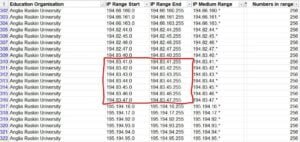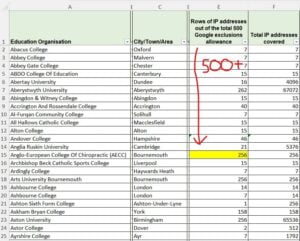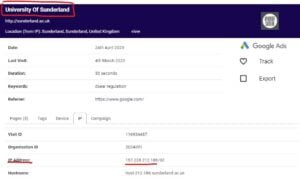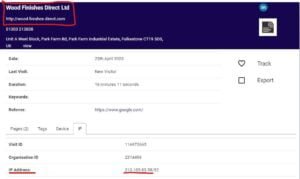Google Ads IP address exclusions limit
Google’s limit of 500 rows of IP exclusions is unethical and causes advertisers to waste too much clicks budget.
Google Ads is supposed to help advertisers benefit from quality clicks to their websites but (unfortunately for you), it doesn’t provide much in the way of help to ensure that you get the best results from your budget.
One method of trying to reduce poor-quality clicks is by excluding IP addresses (or IP address ranges) from seeing your Google Ads, which limits how many irrelevant visitors waste your budget.
What sort of IP addresses would you want to exclude within Google Ads?
These are the most common types of IP addresses that you may want to avoid clicking on your adverts:
- People within your own company (internal or working from home).
- Competitors and suppliers.
- People from within the education sector (e.g. students).
What’s the limit on how many IP addresses can be excluded in Google Ads?
The limit is 500 IP addresses (or ranges) per campaign you have in Google Ads.
If you wanted more than 500 rows then you’d need to have separate campaigns, but that’s painful and still doesn’t solve the real problems, which I’ll cover more further down.
Examples of IP address types you can exclude
I have a database of all IP addresses used within the education sector, and the example here focuses on Anglia Ruskin University, which has 21 blocks of IP address ranges …

Google will allow you to exclude a whole range, so you could enter each of those from the IP Medium Range column in that format (e.g. 194.66.160.*) and it would include all 256 numbers in the range.
So, if you really wanted to block everyone from that one university, then it would use up 21 of your 500 IP exclusion rows.
Look closer at the red outlined data in that table though – a range of IP addresses that effectively go consecutively from 194.83.41.0 to 194.83.47.255. That’s a total of 1,792 IP addresses. Surely Google could provide the flexibility to block them all as one of the 500 rows allowance?
Is there any flexibility on the 500 rows of IP exclusions within Google Ads?
Unfortunately not.
In fact, 500 rows of IP exclusions per campaign doesn’t even scratch the surface of what’s needed.
Why the 500 rows of IP exclusions limitation is of little value to you
If you can identify the IP addresses of these types of visitors then yes, make use of as many of the 500 rows as you can:
- Competitors
- Suppliers
- Staff (internal or working from home)
- Clients (maybe – you don’t really want them clicking on your Google Ads when they search for you).
Beyond that, the 500 rows won’t go far.
The image below is taken from my database that summarises how many IP addresses are within each higher education sector setting alone (in the UK) …

By the time you’ve added in IP address ranges for 14 of those education sector organisations (up to the yellow-highlighted one), you’ve already exceeded your 500 rows allowance.
I totalled up all the data in that spreadsheet (all higher education organisations in the UK – not even including schools), and a fraction of my other list of USA education sector organisations, and it totalled up as:
53,115 rows of IP exclusions you’d need to exclude them all. That’s a lot more than the 500 row limit that Google offer!
That would exclude 8,364,694 IP addresses in total.
This means that you could never get anywhere at all by using the limited 500 rows of IP exclusions that Google allows you.
Why Google doesn’t give you more than 500 IP exclusion rows
In my view, if Google Ads customers want to exclude numerous IP ranges, then they should have the choice to do so – to the level of allowing thousands of rows to be entered into a campaign.
Google would come up with some excuse why they couldn’t do that (lack of server resources is a typical one, which is pathetic considering how many billions they make).
Google knows exactly which IP addresses relate to each searcher in Google. That includes the education sector, as shown in this example from the software I supply:

And Google can also identify other types of visitors, such as this company that was identifiable by IP address (again, from the same software):

Google could even totally dispense with the idea of IP exclusion ranges and actually try to innovate.
They won’t do this of course because they make far too much money from the limited tools they supply to try and limit wastage of Google Ads clicks budget.
The sad reality is that Google make billions of revenue purely from clicks that the advertisers never wanted in the first place, and would have liked a choice to exclude more junk traffic.
But IP exclusions aren’t the definitive answer. This is something I explore in the next part of the page.
What Google should be providing to help Google Ads customers get more from budgets
These two options are just my view of what Google should be offering, and are very much possible to do within the existing data and tech they have available …
Excluding postcodes/areas
I’m in the UK so using a UK example here, but the principle applies worldwide.
Let’s say I want to block Google Ads visibility from anyone in the University of Kent area (CT2 4NZ), because I don’t want clicks from students.
Google knows where people are located when they are searching Google, but they don’t allow you to be specific about the postcode area(s) you don’t want to be visible to.
This means that the current position is that you can only exclude Google Ads visibility within a broad postcode area (such as CT2), but not a more specific area within that (e.g. CT2 4NZ).
The problem with a broad area is that it would exclude ads visibility to everyone in that area, where there could be potential customers in other parts of CT2.
It’s not hard for Google to allow people to enter as many specific postcode areas as they want to, and then block Google Ads visibility to those areas.
But they won’t do it because they make plenty of money by not being customer-focused enough.
Excluding by industry type
Google knows the organisations where people are searching from.
From larger organisations (e.g. a university, an energy company, or Amazon) through to smaller organisations (e.g. a solicitors office or a small engineering business).
What Google ads advertisers are crying out for is the option to enter numerous types of industries that they don’t want their adverts in front of (or, on the flipside, industries that they only want their adverts in front of). These could be very broad, such as:
- Education
- Energy
… or more niche, such as:
- Florists
- Solicitors
- IT support
Google have that information, but they will never implement such a capability because it would massively reduce their revenues when people have such targeting possible.
It’s a stupid mindset for Google to have though because if advertisers started getting more of the clicks they actually want (and those people convert to business), then advertisers will spend more on those clicks.
I imagine that even if Google made such visibility/clicks much higher cost to the advertiser, then advertisers would still prefer them over the scattergun visibility that is the current (as at 2023) reality.
Click Fraud protection tools
Although these don’t relate specifically to IP address exclusions within Google Ads, they do still have a place because such software also knows the ‘wrong’ types of clicks that people may be getting, which enables their Google Ads budget to go further.
The fact that these companies even exist is proof that the Google system itself is incapable of avoiding fraudulent and irrelevant clicks, further reinforcing that Google is not fit for purpose anymore.
Conclusion about IP address exclusions
Although the 500 rows limitation is extremely weak, IP address exclusions aren’t really the answer.
An advertising supply business (Google Ads) should be able to facilitate these types of innovations that enable their paying customers to benefit more from their click budgets:
- Excluding Google Ads visibility by tight geographical areas
- Excluding Google Ads visibility to certain types of industry sectors
- Blocking the majority of irrelevant or fraudulent clicks.
Google have what is effectively a monopoly. The other players (e.g. Bing) are pathetic in their inability to innovate and fight for position, which means that Google can carry on with it’s complacent raking in the billions of revenues.
Maybe one day things will change, but I’m not expecting it to be anytime soon.
If you’ve got any thoughts about this topic, please enter them below or contact me to discuss further.